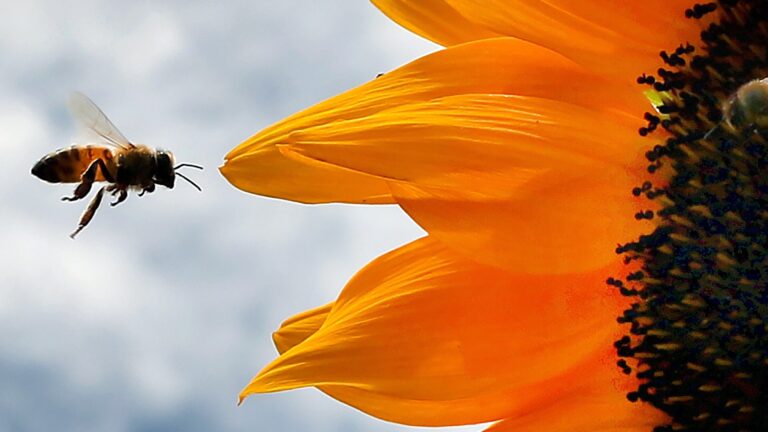
Gardening
Plus, uncovering ways for underground colonies to flourish.

This time of year fills me with such joy and anticipation. Seeing old friends emerge from the ground is almost as rewarding as knowing more are on their way. I am struck by how plants seem to grow inches overnight, especially after rain and the brief exposure to warmer weather earlier in the week.
The verdancy now apparent on the ground is complemented by the songs of spring peepers, tree frogs, and songbirds. So many forms of life are awakening after the long winter, including pollinators and butterflies. Despite the squeals of my children, the bumblebee we spotted in our garden this past weekend was no threat to them, merely a hungry queen looking to build up strength by visiting spring bulbs and flowers. She will soon seek out a nesting cavity to begin laying the eggs of a future colony. I recall being surprised when I learned that only about 5 percent of our native bees are social insects; the majority are solitary creatures, unlike the honeybee, which lives in large colonies.
I am thinking about pollinators in my garden for several reasons. My basement is full of young vegetable plants, annual cut flowers, and perennials, and trends for pollinator health in our region are not good. Recent reports about honeybees is alarming; all the more reason to find ways to support what pollinators remain.
Pollinators continue to face threats through habitat loss, pesticides, and climate change. Beyond honeybees, there are several things we — as gardeners — can do to promote and encourage pollinators to live in our gardens.
As we become more environmentally conscious, there is ever more awareness of how other forms of life interact with the spaces we create. Reader Ann Dorfman has an insightful question about striking a balance between having a formal garden space that can be shared with native bees.
Q. Help! Yesterday I was scuffing up old bark mulch in a large formal garden bed when I noticed a number of bees flying around close to the ground. On closer examination, I realized they were cellophane bees. I think I had just scuffed over their nest holes! Then I noticed a number of bee nest holes in the area where I had not scuffed. Sadly, based on the number of bees flying over the scuffed bark mulch, I think I had already scuffed over a number of nest holes.
My question: This is a formal garden. Can I mulch over the nest holes? If not now, when?
In the future, where can someone like me goes to find an answer to a question like this about supporting our native insects in a timely fashion? Is there a place you recommend I can go to for help?
Ann Dorfman
A. First, I wish to applaud Ann for her keen observations and recognizing what those tiny holes in the mulch represent. For more information, Nick Dorian at the Tufts Pollinator Initiative has written a great article about cellophane bees and their life cycle. There is lots of other great info on local bees, pollinator initiatives, and related resources on the Tufts website. We can really deepen our understanding of the natural world and cultivate a sense of awe when we slow down to look closely at our gardens. You need not sacrifice formality in a garden for creating habitat. Mulch can be applied carefully to minimize covering the nest holes. These bees dig holes that are 1 to 2 feet in depth, and they will be able to push through a light covering of mulch, just not inches thick. Bare earth is needed for ground-nesting pollinators, but not always desirable at the front of a formal bed.
Create alternate patches of bare earth in less prominent places. If you have space between plantings that will grow together over the season, consider leaving some bare patches of earth there. Other maintenance approaches to foster pollinator activity include cutting the stems of last year’s perennials to 18 inches or longer, either leaving them standing or laying them down, a practice that encourages cavity-nesting pollinators.
Leaf litter is another important habitat for pollinators like queen bumblebees and caterpillar cocoons. Try to leave areas in the garden where the leaves can stay undisturbed. Brush piles can be habitat, too, but they need not look messy. With intention, woody brush can be stacked into squares, circles, or curved shapes, thereby making them pleasing to our eyes. Contained within is excellent habitat for many creatures, including the mourning cloak butterfly, who overwinter as adults and are among the earliest butterflies to emerge.
Together, we can each make a positive difference in our gardens with a combination of smart plant choices that support the broadest range of pollinators and maintenance practices that afford respect and space so that we can coexist with these incredible creatures. Spring is a time of hope, of rebirth, and new beginnings. Let this season be the one where we make forward-thinking decisions in our gardens for future generations.
Ulrich Lorimer is the director of horticulture at the Native Plant Trust in Framingham. Send your gardening questions, along with your name/initials and hometown, to [email protected] for possible publication. Some questions are edited for clarity.
Address Newsletter
Our weekly digest on buying, selling, and design, with expert advice and insider neighborhood knowledge.




